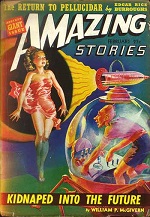The Immortality of Alan Whidden
- by Ralph Milne Farley
- Short Story
- Science Fiction
- Adults
- Definite Time Travel
- English
- “The Immortality of Alan Whidden” by Ralph Milne Farley, in Amazing, February 1942.
The Encyclopedia of Science Fiction characterizes Farley as “a rough-hewn, traditional sense-of-wonder writer,” who “as a consequence became relatively inactive with the greater sophistication of the genre after WWII.” But by the time of this story, Farley’s rough-hewn edges of his 1920s Radio Man stories had been smoothed out, and I find his writing to be engaging. I’ll grant that he never stepped away from the view of women as mere objects of beauty, and his characters have too much purity or evil with no examination of the morality of murdering a greedy man. Also, I have seen only stereotyped presentations of other cultures, but his time-travel plots are still fun and worthy of study. In this story, an immortal man serendipitously invents time travel which takes him from 1949 back to the time of his dastardly grandfather and a consistent resolution of the grandfather paradox.
Framed in the front doorway stood a gloriously radiant girl of under twenty. Her flaunting reddish-brown hair was the first feature that caught Whidden’s admiring gaze. Then her eyes, yellow-green and feral, set wide and at just the least little slant, beneath definitely slanted furry brows of the same tawny color as the hair. Lips, full and inviting. Complexion, pink and cream. And a gingham clad figure, virginally volupuous. A sunbonnet hung down her back from strings tied in a little bow beneath her piquant chin.

Tags
(1)
- Groupings
Variants
(1)
- “The Immortality of Alan Whidden” by Ralph Milne Farley, in Amazing, February 1942.
